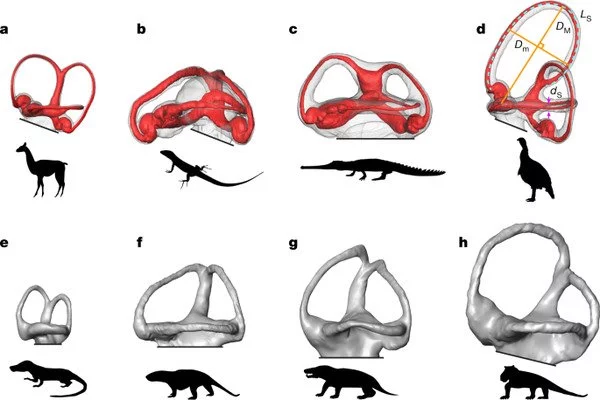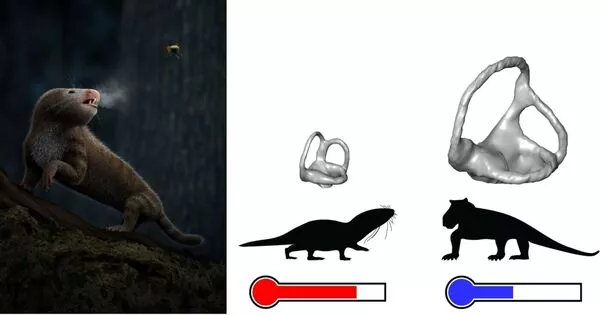Warm-blooded animals are those that can keep their body temperature higher than the temperature of their surroundings. Homeothermic species, in particular, regulate metabolic processes to maintain a stable body temperature. The only known living homeotherms are birds and mammals, with the Argentine black and white tegu being the only living homeothermic lizard. Homeotherms include extinct reptiles such as ichthyosaurs, pterosaurs, plesiosaurs, as well as some non-avian dinosaurs. Other species vary in their degree of thermoregulation.
Warm-bloodedness is an important mammal trait, but it’s unclear when our ancestors developed it. A new study published in Nature suggests that the size of tiny structures in a fossil animal’s inner ears can be used to determine its body temperature. The fluid in our ears becomes runnier at higher temperatures, so animals with warm bodies don’t need as big of canals for it to flow through. Turns out, mammal ancestors became warm-blooded nearly 20 million years later than previously thought.
One of the characteristics that distinguishes mammals is that we are warm-blooded; our bodies have high metabolisms that allow us to maintain our internal temperature regardless of our surroundings, as opposed to cold-blooded animals like lizards, which must bask in the sun. Only mammals and birds are warm-blooded among modern animals, and our ability to keep warm has allowed mammals to survive in icy weather and make long migrations.
However, it is unknown when mammals developed their high metabolisms. Scientists point to an unlikely source for determining when ancient mammal ancestors became warm-blooded in a new study published in Nature: the size of tiny structures in their inner ears.
It’s hard to tell whether a fossil animal was warm-blooded – we can’t take the temperature of a creature that lived hundreds of millions of years ago, and we can only guess at whether its behavior matched an active, warm-blooded metabolism or a slower cold-blooded one. But a team of researchers led by London’s Natural History Museum, the University of Lisbon’s Instituto Superior Técnico, and the Field Museum in Chicago realized that animals’ ears provide an indirect clue about their body temperatures.
One of paleontology’s great unsolved mysteries is the origin of mammalian endothermy. Many different approaches have been used to try to predict when it first evolved, but the results have frequently been ambiguous or contradictory.
Angielczyk
The ears of all vertebrate animals contain tiny canals filled with fluid that aid in balance. The viscosity, or runniness, of that fluid changes with temperature, and our inner ears have evolved different sizes to allow it to flow properly. Cold-blooded animals’ ear fluid is cooler and thicker, necessitating larger spaces for it to travel through, whereas warm-blooded animals’ ear fluid is runnier, necessitating smaller semicircular canals.
“Until now, semicircular canals were commonly used to predict the locomotion of fossil organisms. However, after carefully examining their biomechanics, we concluded that we could also use them to infer body temperatures” says Romain David, a post-doctoral researcher at the Natural History Museum and one of the study’s lead authors.
“This is because, like honey, the fluid contained inside semicircular canals gets less viscous when temperature increases, impacting function. Hence, during the transition to endothermy, morphological adaptations were required to keep optimal performances, and we could track them in mammal ancestors.”

The researchers compared the sizes of the inner ear canals of 341 animals, including 243 living species and 64 extinct ones, to track these evolutionary changes. They discovered that mammal ancestors did not develop the types of inner ear structures required for warm-blooded animals until 233 million years ago, nearly 20 million years later than scientists previously thought.
And, based on the appearance of different-sized semicircular canals in the fossil record, it appears that when mammal ancestors did evolve warm-bloodedness, it happened much faster than scientists had thought, around the same time that proto-mammals began to evolve whiskers, fur, and specialized backbones. The evolution of fur and warm-bloodedness at about the same time especially make sense because fur traps the body heat generated by a higher metabolism, helping keep the body at the high temperature it needs to thrive.
“Contrary to current scientific thinking, our paper surprisingly demonstrates that the acquisition of endothermy seems to have occurred very quickly in geological terms, in less than a million years,” says Ricardo Araújo, junior researcher at Instituto de Plasmas e Fusão Nuclear, Instituto Superior Técnico, University of Lisbon and one of the paper’s lead authors. “It was not a gradual, slow process over tens of millions of years as previously thought, but maybe was attained quickly when triggered by novel mammal-like metabolic pathways and origin of fur.”
Ken Angielczyk, the study’s senior author, expressed excitement about the study’s contribution to answering one of the longest-standing questions about the evolution of mammals.
“One of paleontology’s great unsolved mysteries is the origin of mammalian endothermy. Many different approaches have been used to try to predict when it first evolved, but the results have frequently been ambiguous or contradictory” Angielczyk, the MacArthur Curator of Paleomammalogy at the Field Museum, agrees. “We believe our method has real promise because it has been validated using a very large number of modern species, and it suggests that endothermy evolved at a time when many other features of the mammalian body plan were also falling into place,” the researchers write.





